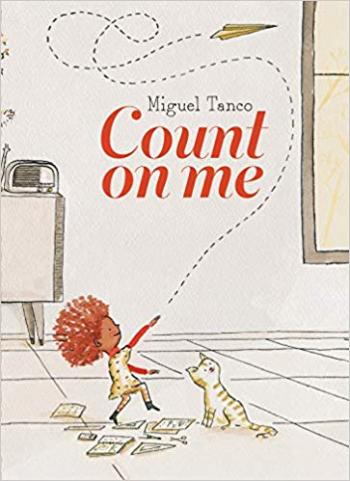
scrounge: /skrounj/ informal verb: to actively seek [books] from any available source

The unnamed girl in Count on Me begins by telling us that everyone has a passion. She shows some of her family members' passions, as well as some of the things she tried that just weren't for her. Then she reveals what her passion is: math. She enjoys looking for it in the world around her, in the form of geometric playground equipment, concentric circles in the water, etc. While this section of the book doesn't go into a lot of detail about mathematical concepts, it serves to present math as a way of seeing the world, as well as to normalize it as something for a girl to do.
At the end of the book, there are several pages describing in more detail how to look for different kinds of math in the real world: fractals, projections, polygons, etc. This section was helpful and gives a more tangible picture of how ubiquitous math is when you know how to look for it. (Despite the title, counting isn't really discussed here.) We enjoyed this book very much, and the watercolor art is beautiful.
(In compliance with FTC guidelines, I disclose that I received this book for free through LibraryThing Early Reviewers. I was not required to write a positive review.)
Scrounged From: LibraryThing
Format: Hardcover
Author/Illustrator: Miguel Tanco
Pages: 48
Content Advisory: None

I'll be honest, words tend to hold much more interest for me than numbers. But that means that if I'm going to learn about a new mathematical concept, a picture book like Blockhead: The Life of Fibonacci is probably the best way to do so.
The author, Joseph D'Agnese, admits in the informational page at the end that very little is actually known of Fibonacci's life. So some aspects of this story are speculation, but we are told the basics: that Leonardo Fibonacci was born in Italy in the 1170s and became one of the greatest known Western mathematicians of the Middle Ages.
This book is written from a first-person perspective, and the title is taken from Fibonacci's nickname, "Bigollo," which could mean "traveler," but could also mean "idler, dreamer, or lazy person." In this story, Fibonacci's obsession with numbers leads to him being labeled as a "blockhead" by some, which of course is not true.
As we learn (through dialog with Fibonacci's friend, Alfredo), Fibonacci not only popularized the Hindu-Arabic numeral system that we use today, but he also noticed numerical patterns in the world around him that came up over and over again. This book includes an explanation of his "rabbit problem," (leading to the Fibonacci sequence) and a visualization of the golden ratio spiral. The illustrations include several other examples of the fibonacci sequence in nature, which readers are invited to go back and search for on the last page.
While the book does not really delve into the implications of these numbers, it still gave me a visually engaging way to learn about them, as well as an appreciation for Fibonacci's curiosity, and the incredible complexity of nature. As Fibonacci tells us at the end, "Now you see why I don't mind being called Blockhead, after all!"
Scrounged From: Amazon
Format: Hardcover
Author: Joseph D'Agnese
Illustrator: John O'Brien
Pages: 40
Content Advisory: None (though some may object to use of the phrase "mother nature")

